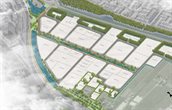Business park Ambachtsezoom combines circularity and climate adaptation
By 2010, the municipality of Hendrik-Ido-Ambacht had already developed plans for a sustainable industrial estate. In 2015, following a visit by the municipal council to the Park20|20 estate in Hoofddorp, the plans for Business Park Ambachtsezoom were revised into a far more ambitious plan: a circular industrial estate. The new plan comprises climate adaptation measures to be implemented by the entrepreneurs.
How is the municipality approaching the project?
Delta Development Group, the company responsible for developing Park20|20, supported the municipality of Hendrik Ido-Ambacht in the development of the Ambachtsezoom estate. The project is based on the circular Cradle to Cradle principle. Cradle to Cradle is a new form of sustainable design and production. After initial use, a product is converted into a raw material for a subsequent product. The municipality thus aims to not only reduce the harmful impact of industrial production, but also to leave a positive footprint for humankind and the planet. The circular industrial estate project involves the following steps:
- The municipality has drawn up a Circularity Manual. This sets out eight goals that together will result in a circular industrial estate. Some examples: the industrial estate will not have any negative impact on the soil; it will feature room for biodiversity; and it will have a positive impact on water management. To achieve all the goals, the manual sets out several measures that are mandatory with respect to public space and private premises.
- The municipality has created a 500-metre-long waterway along and through Ambachtsezoom. This waterway through the middle of the business park is called the Middentocht. The Middentocht connects various natural areas, making it a suitable habitat for all kinds of plants and animals that can also move around easily. Furthermore, two types of banks have been created, a more steep bank where there is also room for plants and animals under water, and a more gentle, nature-friendly bank where lots of reeds will grow.
- A total of 350 trees will be planted on the site. A green buffer of trees will be created between the business park and the residential area, divided into several zones called ‘tree chambers’. Besides various tree species, shrubs such as hawthorn, firethorn and dogwood will be planted. These shrubs attract birds, insects and butterflies. Various grasses and flowers will grow near the trees. This all contributes to biodiversity.
- Rainwater collected in the public space will drain to the wadis in the green areas. These green belts separate public space from private premises. In the event of large amounts of rain, the water will subsequently flow from the wadis to the central waterway of the Middentocht.
- The ambition is for the green design of public spaces to spill over into that of the private areas. To help entrepreneurs green their premises, the municipality has developed the Inspiration Guide Climate & Biodiversity [in Dutch] with the partners of this project.

What progress has been made on the project?
The municipality has already sold a large number of lots. There are also many business premises in Ambachtsezoom already. The development of the business park is expected to take a maximum of ten years. On account of the circular ambition, the lots are garnering wide interest.
Discount when taking additional measures
Entrepreneurs qualify for a discount on the price of their land if they will take one or more additional measures set out in the manual. Examples of additional measures are: semi-paved parking places; additional rooftop buffering capacity; green façades; and fostering biodiversity. The discount – to a maximum of 10 per cent – depends on the type and number of measures. The municipality has developed an instrument to calculate the potential discount.
Municipality aims to inspire others with its story
The municipality of Hendrik-Ido-Ambacht has learned a great deal during the development of the Ambachtsezoom business park and is keen to pass this on to others. With its story, it aims to win over increasingly more people to the circular way of thinking. And sharing successes and lessons learned will obviate the need for others to continually reinvent the wheel. One of the successes for nature, for example, is that biodiversity is already higher now than when it was a polder.
Lessons learned
This project generated the following lessons learned:
- As the municipality is sticking to its ambition of a circular industrial estate, the sale of lots may take longer. Occasionally, buyers attempt to shirk one or more mandatory municipal measures. In such cases, the municipality will help them find alternatives, yet it will stand by its ambition. Most of the entrepreneurs tend to cave in eventually, but some back out of the sale. The advantage of Hendrik-Ido-Ambacht is that industrial lots in and around the municipality are in high demand.
- The municipality has allotted sufficient time for the sale of the lots, something that not every municipality can afford. It is important to take this into account when developing an ambitious plan.
- New construction contributed to the development of Ambachtsezoom. It gave the municipality more freedom, as it did not have to take into account an existing street pattern, for instance.
- Be flexible and make use of progressive insight, also in the realisation phase of the project. If it turns out that something can be done even better, it is a shame if previously drafted requirements prevent this improvement.
- It is important to inform entrepreneurs and property owners about subsidies and discounts. This includes the MIA and Vamil. These are still little used for the construction of green spaces or water storage.
Contact person
Riny Verhoef
Gemeente Hendrik-Ido-Ambacht
mj.verhoef@h-i-ambacht.nl